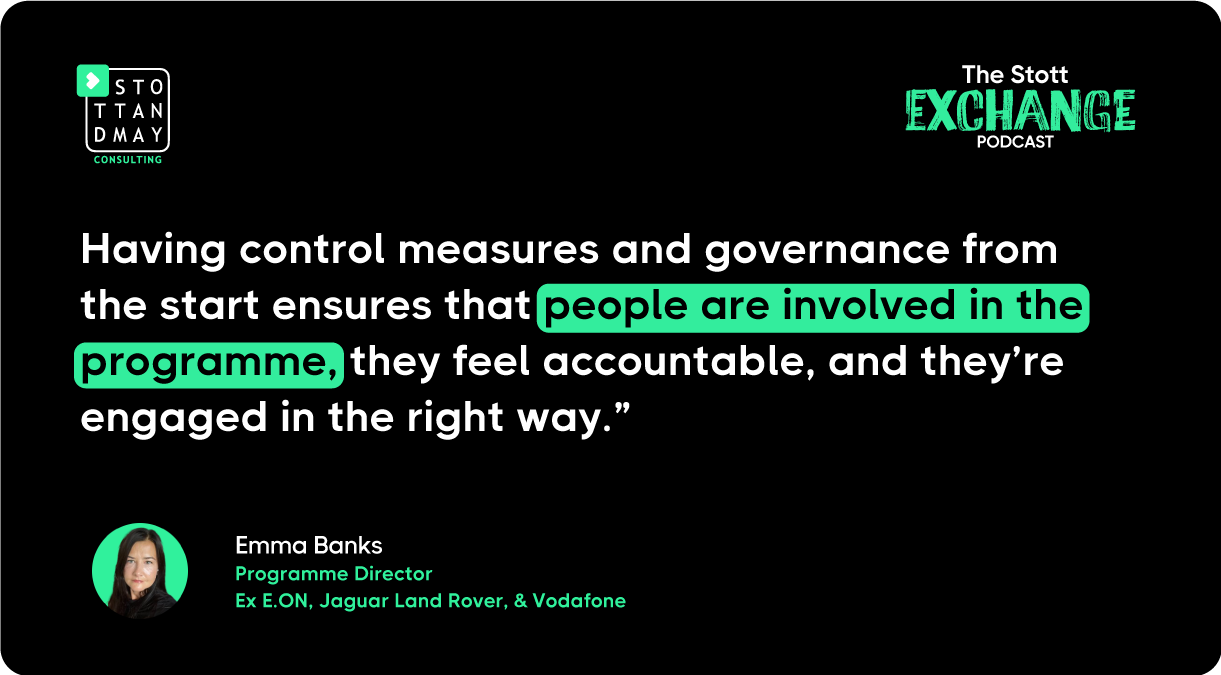In today's rapidly evolving business landscape, organizations face a constant need for transformation and change. Whether adapting to new market demands, modernizing operations, or responding to unforeseen challenges, the ability to navigate transformation effectively is a key driver of success.
Emma Banks, MSc (Oxon), is an experienced delivery professional with over 20 years of expertise in transformation. Throughout her extensive career, she has tackled transformation challenges across the globe in various industries, including Utilities, Automotive, Telco, NHS, and Gaming, with a particular focus on Retail, eCommerce, and Supply Chain. From this diverse background, Emma has a deep understanding of transformation and is passionate about delivering change with control from project inception.
We recently had the pleasure of chatting with Emma on The Stott Exchange Podcast; her advice is practical, battle-tested, and designed to help businesses navigate change with confidence. Below is a brief overview of some of the key takeaways from the conversation; check out this blog post for more in-depth insights, and listen to the full episode below.
5 considerations for effective transformation
Skip ahead to:
- Laying the foundation for success
- Starting with control
- Mitigating risk and ensuring visibility
- Engaging the best and building trust
- Managing closure effectively
1: Be sure of your outcome
It may sound obvious, but actually, without a clear view of the tangibles you can measure or 'sign off' criteria documented and agreed upon as consensus at the very start, the end cannot ever be reached with satisfaction.
From the beginning, assumptions must be eliminated, and the outcome must be readdressed several times through the delivery process. Things always change - a fast start missing this basic need will come back to bite you.
2. Start with control
Without control from the start, you'll run into a number of issues. Part of ensuring this is governance to make sure that people are involved in the program, they feel accountable, and they're engaged in the right way.
If you drive towards a managed kickoff, you can raise the program as a professional brand at the same time - it gives you the opportunity to showcase what it is you're doing. Reiterating the outcomes that you're driving will also help to start the program with confidence from a stakeholder perspective.

3: Always pay attention to risk
The risk register is not just a tedious document to tick boxes - it is one of the most critical tools a delivery leader can utilize. The experts in your team will focus their skills on the task at hand, but the accountability of the delivery leader is to focus on:
- What could go wrong?
- How can this be avoided?
- How will damage control be managed?
If you have too many, create a 'show-stopper' category and separate the critical path items to enable focus and discussion on the right topic that will have the most impact. Also, a project or transformation is hardly ever unique - find out how others have delivered and what went wrong.
4: Engage the best
Choosing the right expertise is critical to delivery success. To do this, it's important to choose a balanced combination of external partners and individuals who possess the skills needed for various aspects of transformation, including technical, process, and governance expertise.
“The right expertise is critical to delivery success.”
Choose a balanced combination of external partners and individuals who possess the skills needed for various aspects of transformation.

Emma Banks
Delivery Consultant & Programme Director
Additionally, it's essential to tap into the knowledge of your internal employees to gain insights into your organization and how to navigate it effectively.
5. Manage closure effectively
A managed closure is almost a repeat of the managed setup, reflecting on and re-addressing:
- What were we supposed to do?
- What was the outcome we agreed on at the beginning?
- What were the assumptions we agreed on?
Essentially, it's about looking at where you started and where you ended because, as we've discussed, it won't be the same: Things always change. You need to have visibility of the changes adopted by the people who will remain once the project team has left. It also produces traceability for internal audits.
Tracking progress from the beginning, adopting changes, and ensuring a proper handover are all key components of a successful closure.
In summary
Wherever you are in your change journey, Stott and May Consulting provide a range of services to support organizations in making technology transformation more productive. Find out more and get in touch to see how we can deliver your technology initiatives with predictable precision here.




